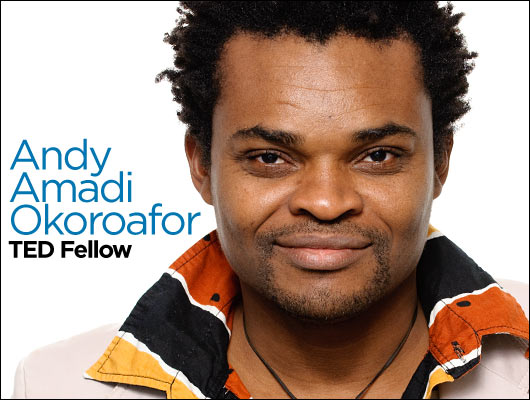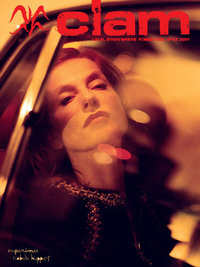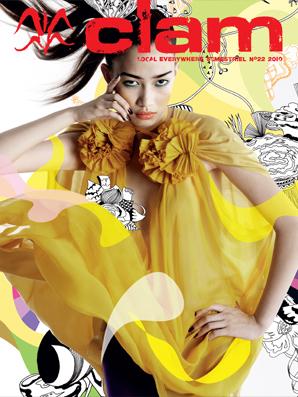 Andy Amadi Okoroafor, founder of creative studio Clam, loves to use imagery in different ways, from fashion to film. Here, he reveals how shortwave radio influences his work – including his internationally successful Clam Magazine — and his latest scheme to make social entrepreneurs sexy.
Andy Amadi Okoroafor, founder of creative studio Clam, loves to use imagery in different ways, from fashion to film. Here, he reveals how shortwave radio influences his work – including his internationally successful Clam Magazine — and his latest scheme to make social entrepreneurs sexy.
Interactive Fellows Friday Feature!
Join the conversation by answering Fellows’ weekly questions via Facebook. This week, Andy asks:
Click here to respond!
We’ve seen design, films, magazines, and so much more come from Clam. Tell us about Clam.
Clam is about images: it’s a venue to think about images, develop images, and also to make a living from doing images — I’m passionate about images.
At the Clam studio we mostly do image development for people. I develop image concepts for clients, graphic design and, of course, advertisements. We also do books, cards, exhibitions, image-related events and even private concerts – anything to do with images. That’s the commercial arm of Clam.
Two times a year we publish the magazine Clam, which has been my curse and my happiness. It’s my curse because it’s become so popular, people think that’s what I do. I’ve been doing it for 10 years and people think I just do magazines, but I really just do it twice a year.
Clam Magazine is published in Japan, the US, Europe, and Brazil. It’s a visual magazine with an interesting mix of people in it. It’s also in different languages. This is our 11th year of doing the Clam magazine. It has become famous, but it’s not a commercial magazine: we don’t allow too many advertisements in the magazine (though we do try to get sponsorship sometimes).
The idea for the magazine was just to talk about what we really like. We do it because we like to do it. We don’t do trends. If we became trendy, we’d just phase out. We don’t talk about fashion shows, new gadgets to have, etc. But I guess it’s still a fashion magazine, in a way, because it’s actually a magazine about creativity, presented visually. It’s also about social entrepreneurship, innovation, and a whole lot more, but it’s done from a very humane point of view.
What led you to your current career path?
My biggest work experiences have been in music, fashion and visual communication, even though I studied cinema. After working in fashion for years I was headhunted to Virgin France. I spent 5 years art directing music videos. I did their imagery, from the album covers to music video. Then I left to go develop my first feature film, Relentless. I am happy to be back in cinema.
In October, Relentless was selected for the London film festival, and on December 6th Relentless was shown for the first time in Africa, at the African International Film Festival in Port Harcourt. It was exciting for me to see the four screens packed and people begging to come in to see my film, in my country. Clam produced and raised the financing of the film. It’s a big deal for a small company like us.
What’s next for Clam?
I want to meet TED Fellows who are into films, fashion and creativity in Asia, because I want to do my next film in Asia. I’m especially into Korea and Japan: I know Seoul and have been there a lot. One of the reasons I wrote the story was because of Seoul. I also want to talk more about Asia in Clam Magazine: more about India, Malaysia, Indonesia … Lebanon rocks, too … etc.
People who meet me are always surprised I’m the one doing the magazine. It doesn’t fit the aesthetics cliché of what an African doing imagery “should” be doing. But I’m African, Nigerian….but my work has a world view.
I like the fact that my magazine is sold next to the French Vogue in New York City. The fact that the distributors do think the two are kind of related makes me laugh … but it’s what Clam is all about. My work is multicultural. Our concept is, “local everywhere.” That’s Clam’s tagline.
How has your background influenced your work?
It has influenced me in a lot of ways. I was one year old when the war started in Biafra. So it has a lot of influence on my psyche, about what I think about life.
The logo of Clam was done in my village. The logo and the whole concept of Clam were done in my village on my dad’s balcony in between shortwave radio programs.
What has influenced me the most is shortwave radio: it’s about changing dials. I’m going to give you a little secret about shortwave radio and my work: if you go one millimeter, you go from Russia to Afghanistan. You move very fast in a very short space. You change influences, you change imagery, you change sound … so if you translate that to imagery, that’s what I do. You can read Clam from back to front or front to back – that’s how it works. You can dial forward, dial back to get to any point. My process on imagery is based on that: shortwave radio. That’s why my magazine looks the way it looks. I even tried this concept on my film Relentless.
I watch a lot of Korean films and they have influenced me a great deal. Film-wise, Wong Kar-wai, Im Sang-soo and Shohei Imamura are people who influenced me a lot, and of course Jean-Luc Godard. I moved to Paris in 1986 to study cinema because of Godard. (I didn’t know he was Swiss). People like John Paul Goude, Helmut Newton and Harry Peccinotti are my other visual influences.
But I think the biggest influence of my life is sitting on my parents’ balcony in the village and listening to shortwave radio.
How has the TED Fellowship influenced you?
I found like-minded people at TED and it reinforced what I already believed. I found a certain kind of connection to a certain kind of mind-state, a certain attitude and life-view that I like very much.
I have an ambition about what I want to do with TED. This is an influence TED had on me, and it’s also a challenge to the TED community: I want to make social entrepreneurs sexy. I want people to look at them the way they look at a rock star or a movie star.
My challenge right now is, the way I would work with a musician, a product, or film, I want to do the same with social entrepreneurs. I want Clam to become the destination for social entrepreneurs to develop their imagery. That’s something I really believe in. Because I think social entrepreneurs are the new artists – I wrote that in the new editorial of Clam. Before, Clam Magazine didn’t have social entrepreneurs. I’ve started putting them in because of TED. I am even doing the new Clam website with Apurv Mishra, a Ted Fellow … we are trying something crazy….
Sometimes kids with problems with school or social life use their frustration to learn to play the guitar, start a band, or DJ in clubs. If their stuff works, voila, all of a sudden they’re the cool kid. I think the way music becomes people’s escape, social entrepreneurship — if it works on its strengths — can become a positive escape for a lot of youths in the world. It gives them an outlet for their energy, something to dedicate themselves to, and it’s a form of expression. That’s really my belief.
I want to work on social entrepreneurs to be that cool. That’s the whole idea behind it. If young people become that impressed with social entrepreneurs, they will follow them and want to go out and work for Amnesty International, Samarsource or Ushindi, they’ll want to be TED Fellows, because it is the cool thing to do. Not only because it is the right thing, but because it’s actually the cool thing to do. Make the right thing cool!
That’s basically my idea.
For me, social entrepreneurs are the new rock stars, and that’s what Clam wants to develop. Some areas of social entrepreneurship are already seen as sexy, but some need more help. And we can enhance that….and you don’t need crocodile pants or a fake swagger or a drug habit …helping raise funds for a project in the DRC should be as cool as writing a great song after your girlfriend left you…that’s the crazy point I am trying to make! If we get that across to young people, the world will share more and we will care for each other more.
Being at TED has helped me so much to legitimize that thought.
There are many aspiring social entrepreneurs out there who are trying to take their passion and ideas to the next level. What is one piece of advice you would give to them based on your own experiences and successes? Learn more about how to become a great social entrepreneur from all of the TED Fellows on the Case Foundation blog.
My advice for social entrepreneurs is to know that they are the most interesting thing happening in the world right now. They shouldn’t be buried in their computers, you know? They are changing the world; they should also live in the world they are changing.
Social entrepreneurs are the most remarkable people right now on any level, whether in music, art, business … for me they are the coolest thing. But I think there’s a reticence about expressing that you’re doing good. It’s hard to say “Hey, I’ve done this and that and I’m helping people build schools and hospitals.” What’s cooler than that? Designing a new collection, a sofa, a car, a hotel, becoming the new Banksy? Nah, nothing comes close!
The world has made social entrepreneurs seem unimportant, but this is actually what is important right now. This is what young people want to be into. Its just the gates seem closed … you think you can’t make out in that crowd. That’s why something like TED becomes so important. It’s cool to be a TED Fellow.
Social entrepreneurs should blow their own horn a bit more.
It sounds like you are always working on a million ideas at once. What do you do to relax and get away from work?
I don’t see life that way, because for me work and play are mixed. I enjoy what I do, I do what I enjoy, mostly. When I’m on a film set, I don’t think of it as being at work.
I like music a lot. I go to the movies, I travel a lot. I just enjoy life when I’m doing this. I don’t have that, “this is work, and this is play” mentality. I don’t drink, I don’t smoke, I don’t do drugs, so I don’t have that kind of split in my life. Ah, I am sounding too good! I have my bad parts too, please … things are mixed.
I don’t have ideas all the time. Sometimes I have no ideas, but I still do the same thing. [Laughs]. I don’t have ideas all the time. You met me on a good day.



Comments (5)
Pingback: Relentless – Trailer « « MyWeku.com MyWeku.com
Pingback: TED Fellows 2012 申请现已开始 « 在武汉
Pingback: The Bright and Early
Pingback: FELLOWS FRIDAY WITH ANDY AMADI OKOROAFOR « tedx oman